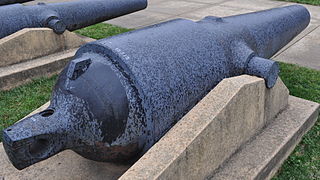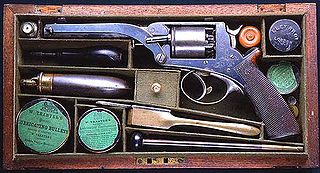 W
WIn modern terminology, the Arkansas toothpick is a heavy dagger with a 12-to-20-inch pointed, straight blade. The knife can be used for thrusting and slashing. James Black, known for improving the Bowie knife, is credited with inventing the Arkansas toothpick.
 W
WThe Beaumont–Adams revolver is a black powder, double-action, percussion revolver. Originally adopted by the British Army in .442 calibre in 1856, it was replaced in British service in 1880 by the .476 calibre Enfield Mk I revolver.
 W
WA Bowie knife is a pattern of fixed-blade fighting knife created by James Black in the early 19th century for Jim Bowie, who had become famous for his use of a large knife at a duel known as the Sandbar Fight.
 W
WThe Brooke rifle was a type of rifled, muzzle-loading naval and coast defense gun designed by John Mercer Brooke, an officer in the Confederate States Navy. They were produced by plants in Richmond, Virginia, and Selma, Alabama, between 1861 and 1865 during the American Civil War. They served afloat on Confederate ships and ashore in coast defense batteries operated by the Confederate States Army.
 W
WThe Colt Revolving Belt Pistol or Navy Pistol, sometimes erroneously referred to as "Colt Revolving Belt Pistol of Naval Caliber" or "of Navy Caliber", is a cap and ball revolver that was designed by Samuel Colt between 1847 and 1850. Colt first referred to this Revolver as the Ranger Size model, and then Revolving Belt, but the designation "Navy" quickly took over.
 W
WThe Colt Army Model 1860 is a cap & ball .44-caliber single-action revolver used during the American Civil War made by Colt's Manufacturing Company. It was used as a side arm by cavalry, infantry, artillery troops, and naval forces.
 W
WThe Colt Model 1861 Navy cap & ball .36-caliber revolver was a six-shot, single-action percussion weapon produced by Colt's Manufacturing Company from 1861 until 1873. It incorporated the "creeping" or ratchet loading lever and round barrel of the .44-caliber Army Model of 1860 but had a barrel one half inch shorter, at 7.5 inches. Total production was 38,000 revolvers.
 W
WThe Colt Walker, sometimes known as the Walker Colt, is a single-action revolver with a revolving cylinder holding six charges of black powder behind six bullets. It was designed in 1846 by American firearms inventor Samuel Colt to the specifications of Captain Samuel Hamilton Walker.
 W
WThe Enfield Pattern 1853 rifle-musket was a .577 calibre Minié-type muzzle-loading rifled musket, used by the British Empire from 1853 to 1867; after which many were replaced in service by the cartridge-loaded Snider–Enfield rifle.
 W
WThe Fayetteville Rifle was a 2 banded rifle produced at the Confederate States Arsenal in Fayetteville, North Carolina. The machinery which produced these weapons was primarily that captured at the United States Arsenal at Harpers Ferry, Virginia, which was previously used to produce the US Model 1855 Rifle.
 W
WKerr's Patent Revolver was an unusual 5-shot single-action revolver manufactured from 1859 to 1866 by the London Armoury Company. It was used by Confederate cavalrymen during the U.S. Civil War. Seven of these revolvers were held by the New Zealand Colonial Defence Force in 1863 and were issued to the famous Forest Rangers at the start of the campaign to push Maori rebels out of the Auckland province. It is easily recognized by its side-mounted hammer.
 W
WThe LeMat revolver was a .42 or .36 caliber cap & ball black powder revolver invented by Jean Alexandre LeMat of New Orleans, which featured an unusual secondary 20 gauge smooth-bore barrel capable of firing buckshot. It saw service with the armed forces of the Confederate States of America during the American Civil War of 1861–65 and the Army of the Government of National Defense during the Franco-Prussian War.
 W
WThe London Armoury Company was a London arms manufactory that existed from 1856 until 1866. It was the major arms supplier to the Confederacy during the U.S. Civil War. The same company name was used during World War I to import arms from America such as the Colt New Service Revolver in 455 Eley.
 W
WThe long rifle, also known as longrifle, Kentucky rifle, Pennsylvania rifle, or American longrifle, was one of the first commonly used rifles for hunting and warfare. It is characterized by an unusually long barrel, a development in American rifles that was uncommon in European rifles of the same period.
 W
WThe M1841 Mississippi rifle is a muzzle-loading percussion rifle used in the Mexican–American War and the American Civil War.
 W
WThe U.S. M1814 rifle was designed by Robert T. Wickham. The manufacturing was contracted out to Henry Deringer and R. Johnson to make rifles for use by the military.
 W
WThe Springfield Model 1816 was a .69 caliber flintlock musket manufactured in the United States during the early 19th century.
 W
WThe Springfield Model 1822 was a .69 caliber flintlock musket manufactured by the United States in the early 19th century.
 W
WThe Pattern 1861 Enfield musketoon was a short-barrel version of the Pattern 1853 Enfield rifled musket, having a faster rifling twist rate, along with more rifling grooves, which made it more accurate than the original rifle. The shorter rifle was therefore easier to carry and reload.
 W
WThe Remington-Beals Model Revolvers along with subsequent models and variations were percussion revolvers manufactured by Eliphalet Remington & Sons in .31 (Pocket) .36 (Navy) or .44 (Army) caliber, used during the American Civil War, and was the beginning of a successful line of medium and large frame pistols. They are commonly, though inaccurately, referred to as the Model 1858 due to the patent markings on its New Model barrels, "PATENTED SEPT. 14, 1858/E. REMINGTON & SONS, ILION, NEW YORK, U.S.A./NEW MODEL."; although wide scale production did not start until 1861.
 W
WThe Richmond rifle was a rifled musket produced by the Richmond Armory in Richmond, Virginia, for use by the Confederate States Army during the American Civil War.
 W
WThe Savage 1861 Navy was a cap and ball revolver manufactured by the Savage Revolving Firearms Company from 1861 to 1862. This company is unrelated to the later Savage Arms Company. It was used by both sides during the American Civil War.
 W
WThe Smith & Wesson Model No. 2 Army a.k.a. Model No. 2 Old Model Smith & Wesson Revolver was Smith & Wesson's first .32 caliber revolver, intended to combine the small size and convenience of the Smith & Wesson Model 1 .22 rimfire with a larger caliber. Chambered in the .32 rimfire long caliber, its cylinder held 6 shots. It was manufactured 1861 - 1874, with a total production of 77,020.
 W
WThe Springfield Model 1840 was a flintlock musket manufactured by the United States during the mid-19th century. The .69 caliber musket had a 42-inch (107 cm) barrel, an overall length of 58 inches (147 cm), and a weight of 9.8 pounds (4.4 kg). More than 30,000 were produced by the Springfield and Harpers Ferry armories and two independent contractors between 1840 and 1846.
 W
WThe Springfield Model 1842 was a .69 caliber musket manufactured and used in the United States during the mid-19th century. It is a continuation of the Springfield Model 1816 line of muskets but is generally referred to as its own model number rather than just a variant of the Model 1816.
The Springfield Model 1855 was a rifle musket widely used in the American Civil War. It exploited the advantages of the new conical Minié ball, which could be deadly at over 1,000 yards. About 60,000 of these rifles were made, and it was a standard infantry weapon for Union and Confederates alike, until the Springfield Model 1861 supplanted it, obviating the use of the insufficiently waterproof Maynard tape primer.
 W
WThe Springfield Model 1861 was a Minié-type rifled musket shoulder-arm used by the United States Army and Marine Corps during the American Civil War. Commonly referred to as the "Springfield", it was the most widely used U.S. Army weapon during the Civil War, favored for its range, accuracy, and reliability.
 W
WThe Springfield Model 1863 was a .58 caliber rifled musket manufactured by the Springfield Armory and independent contractors between 1863 and 1865.
 W
WThe Tranter revolver was a double-action cap & ball revolver invented around 1856 by English firearms designer William Tranter (1816–1890). Originally operated with a special dual-trigger mechanism later models employed a single-trigger mechanism much the same as that found in the contemporary Beaumont–Adams revolver.